Beans, beans, the musical … I’ll stop now. Ahem … I’m an adult. Right.
Hello! How are you? Do you love beans? Beans as a main, beans as a side, beans in chili, beans in everything? Me too! They’re a vegetarian’s best friend, but they’re everyone’s best friend, too. Chock full of satiating protein and filling fiber … beans are good stuff. 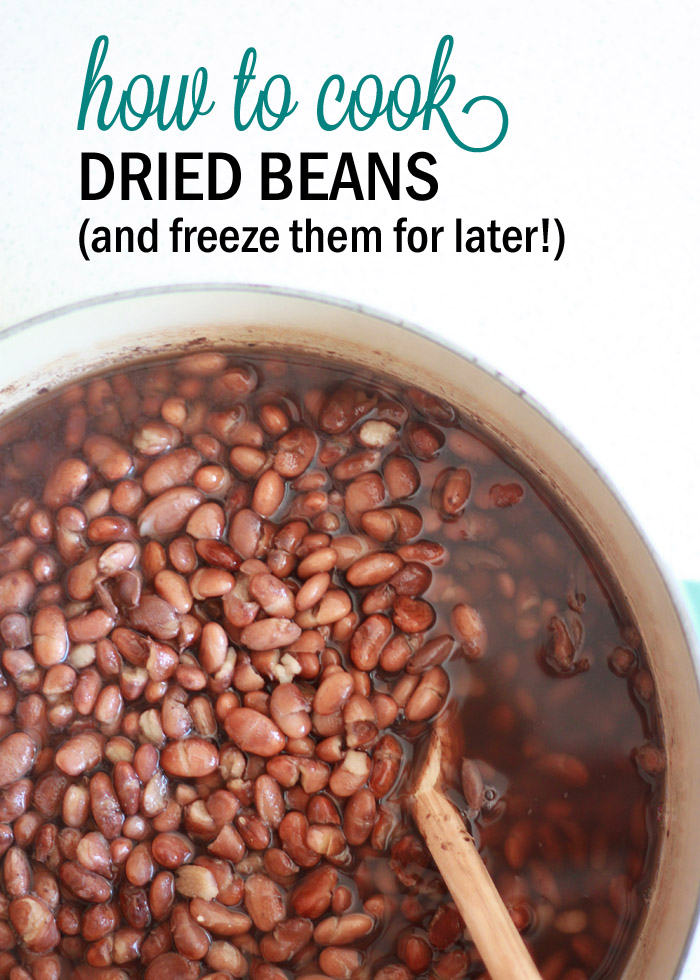
Most recipes these days call for beans by the 15-ounce can, but it really pains me to pay for canned beans when I know that I can save a ton of money by buying dried beans, cooking them at home myself, and freezing them for later. It makes me feel all virtuous when I grab a 2-cup bag of beans from the freezer instead of opening a can that cost me way more. 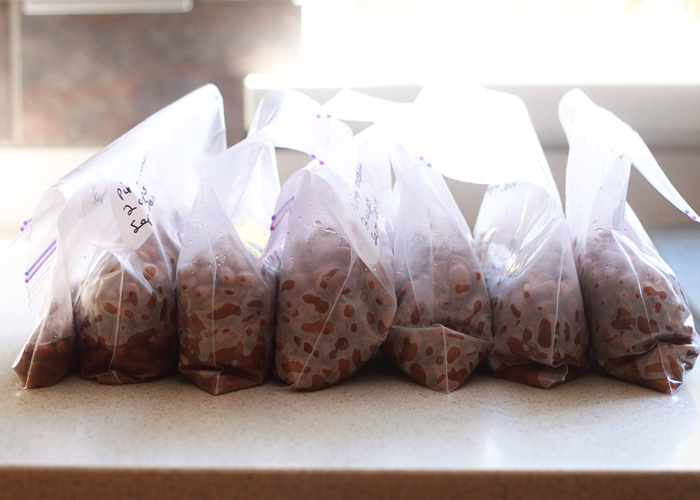
How much money will I save by doing this, you ask? A ton!
Do you get excited when you find your favorite brand of shoes (in the color you want! and your size!!) for 60% off? Me too! So I love cooking my own dried beans from scratch, because when I do it this way, I save about 55-60% over buying canned. And that’s a conservative estimate.
I had a whole paragraph about the math, but it was way too crazy involved. In a nutshell: If you prepare a pound of pinto beans that cost you $1.99, it should equate to paying about 65 cents per 15-ounce can. A great deal, right?!
You might also wonder: Will my beans taste better? Well, honestly, I go back and forth on this. They don’t necessarily taste better than canned, but there’s something … fresher … about beans prepared at home. Of course, that could be all in my mind. Plus, you control the sodium content, which is nice.
If you’re new to the cooking beans game, you might be thinking, “dude, this is not worth all the work!” Well, I promise it’s not much hands-on – maybe 20 minutes total. And once you get a rhythm down, you’ll be whizzing through the process – the perfect side-project for a weekend day or when you have half a day or so to just putter around the house.
Okay! Let’s do this! There are five steps to cooking dried beans and freezing them for later.
- Get prepped
- Rinse and sort through the dried beans
- Soak your beans
- Cook your beans
- Bag and freeze
Here’s the breakdown:
Get prepped
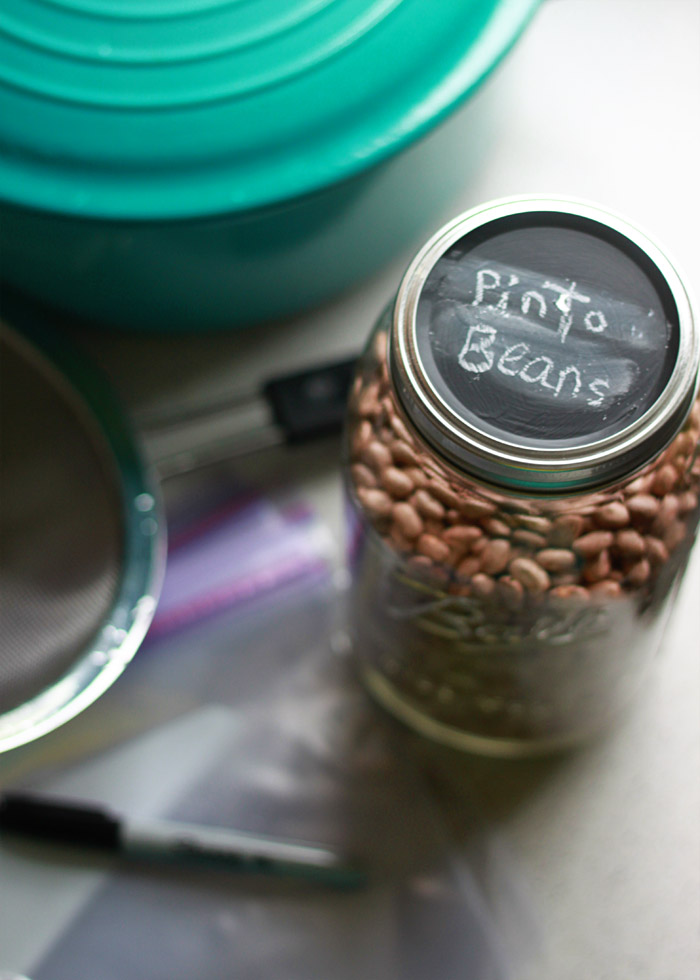
To get started, you’ll need:
-
- Time. Cooking dried beans takes some time from beginning to end, but most of that is hands-off. Depending on your soaking method (more about that below), you want to plan ahead. For the overnight process, you’re looking at about 12 hours from beginning to end. Quick soak, more like three. I usually reserve the bean-cooking for when I know I’m going to be hanging at home for much of the day.
- Dried beans. You can buy them by the bag at most grocery stores, or I like to grab organic beans from the bulk section of well-stocked grocery stores like Whole Foods. I most often stock up on common varieties like black beans, white navy beans, cannellinis, red kidney beans, and pinto beans.
- A large pot. I cook two pounds of beans at a time in a 7 1/4 quart pot, and it’s just barely big enough.
- A large colander or large sturdy sieve. Small holes (smaller than your beans!) and as roomy as possible.
- Freezer bags and a sharpie. Because nothing’s worse than mystery freezer food that’s not labeled!
Rinse and sort through the dried beans
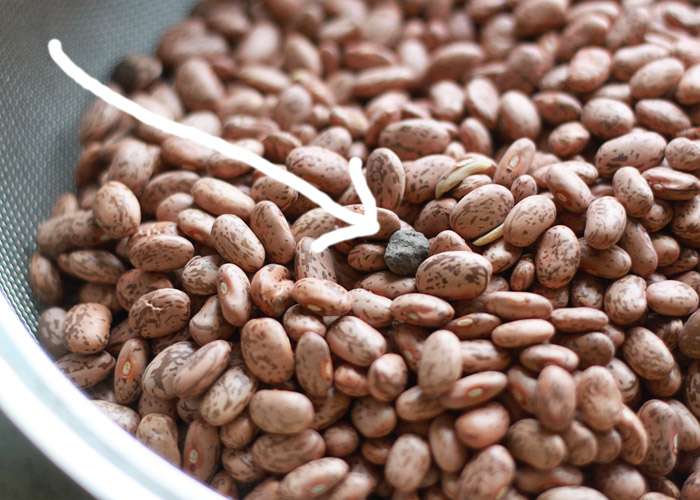
Put the beans in a large colander, a few at a time, and pick through them. See any weird bits and pieces? Discard them. It doesn’t happen all the time, but debris like rock or clumps of dirt can definitely be present, so inspect those beans carefully! Also discard badly broken beans or shriveled bits while you’re at it. Rinse, swish, and look through them again. 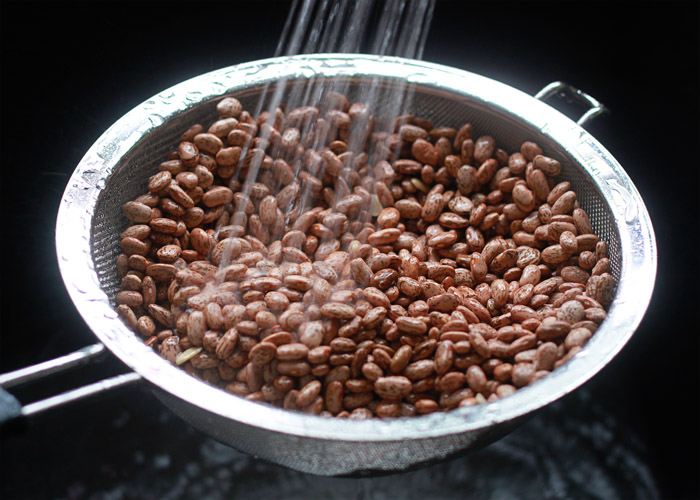
I then flick them into the soaking and cooking pot, a few at a time, checking the beans carefully one last time. A little insurance that I didn’t miss anything. 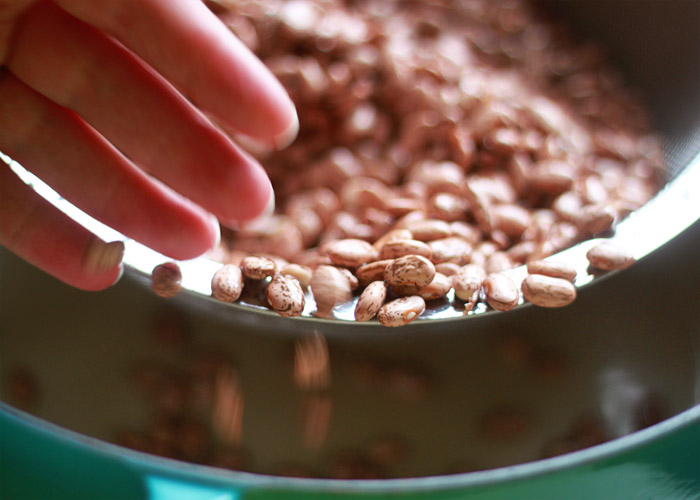
Soak your beans
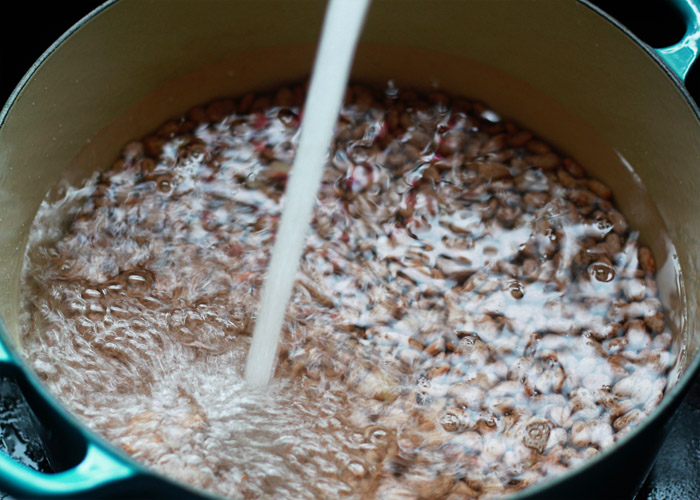
First off, a question that’s often asked: Do I need to soak my beans? My answer is yes! That is, unless you want righteous gas (hey, sometimes it’s important to be blunt.) Soaking the beans (and then discarding that gas-laden soaking water) helps get rid of flatulence-causing compounds. Plus, especially with harder beans, it helps them to cook faster. Both good reasons to soak those beans!
So how do you soak them? Let me count the ways. Okay, there are two. They both start with placing the rinsed and sorted beans into the pot and then filling the pot with water to about two inches above the beans. And then choose your soaking method:
Overnight Soak
I usually do an overnight soak – it’s just less fussy to fill the bean-filled pot with water and let it sit overnight. Then all you do is drain, rinse, and cook.
Quick Soak
As the name indicates, this is a faster way to soak your beans. Place your beans and water on the stove over high heat. Bring to a boil and boil for 2-3 minutes. remove the pot from heat and cover. Let sit for 1 hour then proceed.
Cook your beans
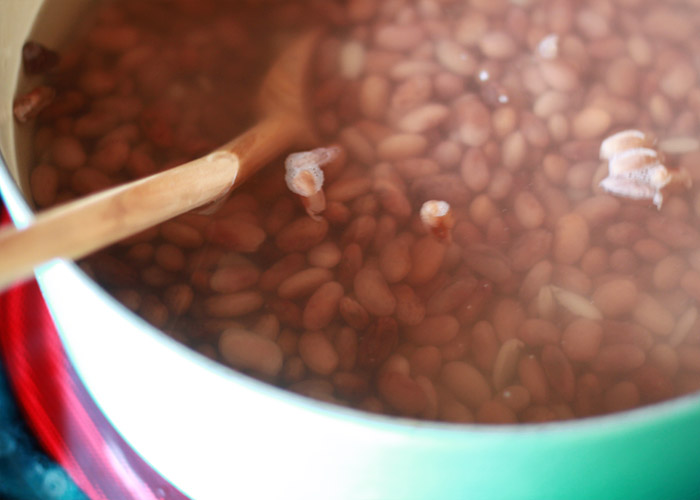
Drain the soaking water, rinse and swish the soaked beans, and drain again. I use the colander or sieve for this.
And now it’s time to cook! Add fresh water to the pot of soaked beans, to about two inches above the top of the beans. I don’t season the beans. I used to add a hefty pinch of salt and a glug of olive oil which gave the beans great flavor, but they would cook up mushier. I didn’t like that. So now I just go for straight-up beans – maybe a bay leaf if I’m feeling fancy. Strangely, the common thought is that salt will make the beans tough, but I didn’t experience that. Just mushiness.
Place the pot over high heat and bring to a boil. As soon as it comes to a boil, give the beans a stir and reduce the heat to right around medium-low until you find the right temp to maintain a simmer. Cover beans, leaving the lid partially askew to help a bit of the steam to escape.
Cook the beans for anywhere from 30 – 60 minutes or possibly even more, depending on how tough your variety is, until tender. Depending on the type of bean, they may cook fast (such as navy beans) or they may take longer (such as kidney beans). A special note on kidney beans, by the way: Make sure they’re cooked through! Raw and undercooked kidney beans contain a toxin that can cause gastric issues, so cook them well!
My favorite way to tell the beans are done? Use a slotted spoon to scoop a few out and blow on the beans. If the skin peels and curls up, your beans should be cooked. Try one to be sure!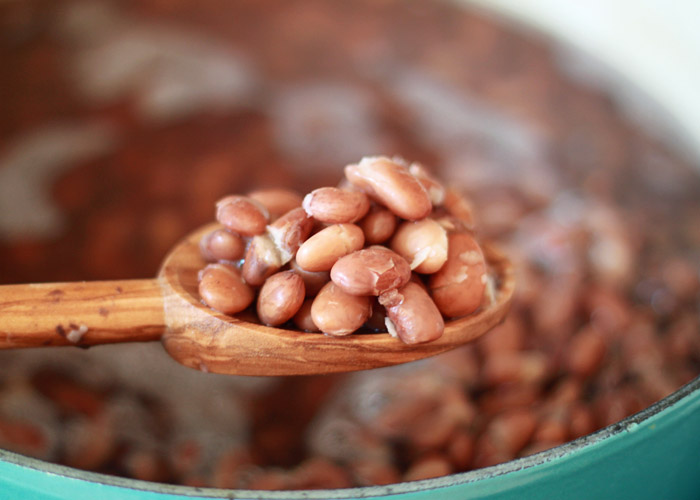
Once the beans are cooked, uncover them and remove them from the heat. Let them cool. 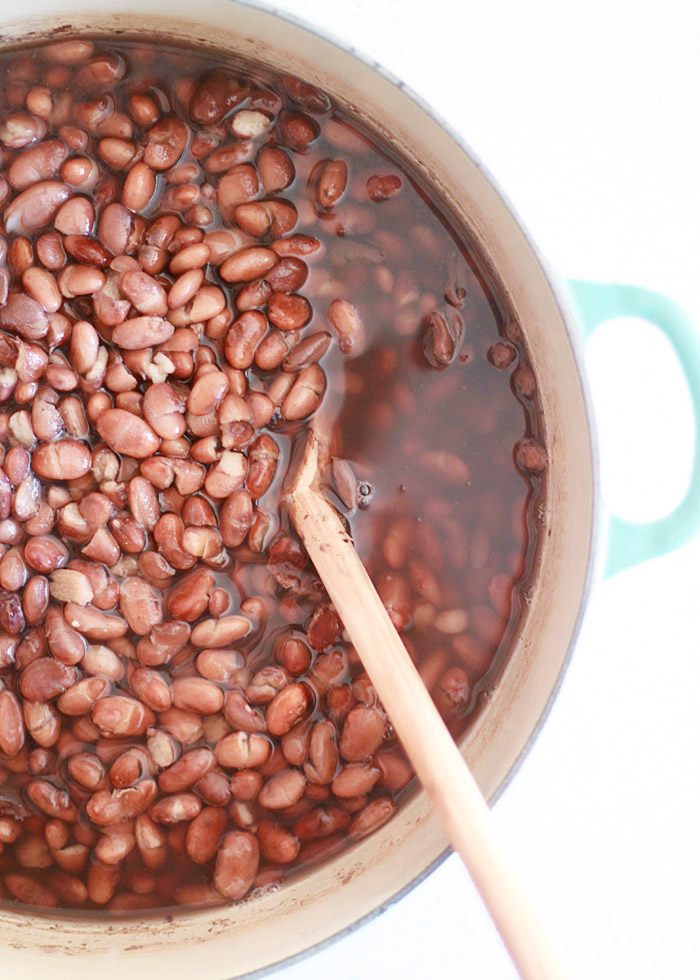
Freeze and bag your beans
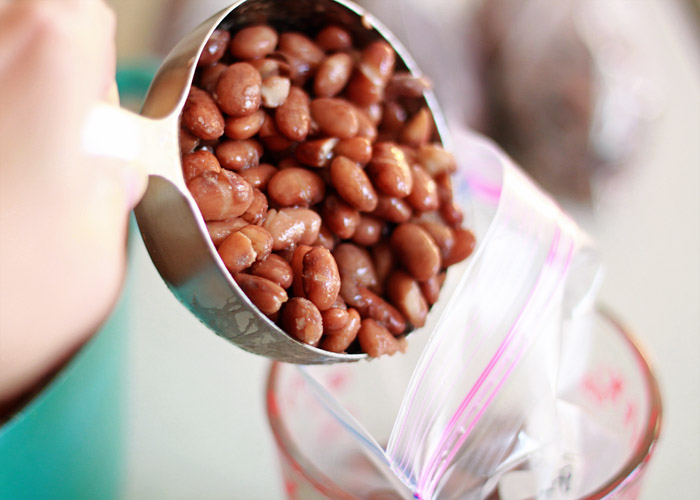
Once cool, drain the cooking water from the beans. Some people like saving the bean broth for other uses like soups.
Label several freezer-safe zipper bags with a permanent marker like a Sharpie – I list the variety, quantity, and date.
I then set the bag in a small bowl or 2-cup liquid measuring cup and measure the beans into each by the cupful. I freeze in two-cup increments – roughly the same amount as a can of beans – so I can do the one-for-one thing when cooking up recipes. One bag = one can.
Okay! You’re done! Now transfer your beans to the freezer, and you’re all set. They should keep up to six months. 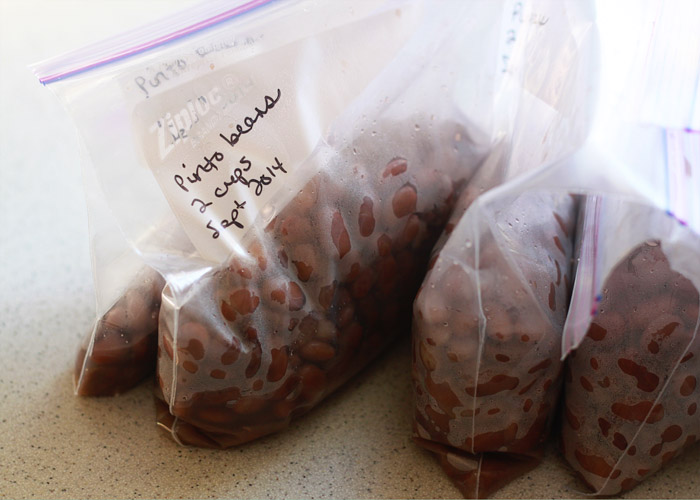
I pull the beans out of the freezer and add them to hot recipes – like chili or beans and rice – frozen, right out of the bag. But for recipes where I need to start with thawed beans, I’ll pull them out the night before and let them thaw in the fridge, or place the sealed bag in a large bowl of warm water to quick-thaw.
Cool beans!
Resources
I’ve cooked beans plenty enough to feel confident writing this post, but I wanted to be sure I was right, so I fact-checked at these two sites (which, by the way, are great references if you want to learn more): The Bean Institute and Whole Foods Food Guide for Beans
If you try this recipe, please leave a rating! And, if you find it share-worthy – which I hope you do – please share. Tag #kitchentreaty on Instagram, Facebook, or Pinterest, and don’t forget to check out my other recipes!
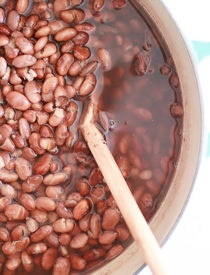
How to Cook Dried Beans and Freeze Them For Later
Ingredients
- 2 pounds beans
- Water
Equipment:
Equipment
- Very large pot (7 quarts or larger)
- Large colander or sieve
- Freezer-safe zipper bags
- Sharpie permanent marker
Instructions
- Rinse and sort through the dried beans. Put the beans in a large colander, a few at a time, and pick through them. Discard any weird bits and pieces like rock, clumps of dirt, badly broken beans or shriveled bits. Rinse, swish, and look through them again. Flick them into the soaking and cooking pot, a few at a time, checking the beans carefully one last time.
- Place the rinsed and sorted beans into the pot and fill with water to about two inches above the beans. Either cover and let sit overnight to soak, or, to do the quick soak method, place your beans and water on the stove over high heat. Bring to a boil and boil for 2-3 minutes. Remove the pot from heat and cover. Let sit for 1 hour.
- Drain the soaking water, rinse and swish the soaked beans, and drain again.
- Add fresh water to the pot of soaked beans, to about two inches above the top of the beans. Place the pot over high heat and bring to a boil. Reduce heat to a simmer and partially cover beans.
- Cook the beans until tender and the skins peel when you blow on them, 30 - 60 minutes, depending on the type of bean. If you're cooking kidney beans, cook them well! Raw or undercooked kidney beans can be toxic.
- Remove from heat, uncover, and let cool.
- Once cool, drain the cooking water. Label your freezer bags and scoop beans into bags. Seal and transfer to freezer until ready to use in your cooking, just like you would a drained can of beans. Beans keep in the freezer for about 6 months.
- To use, just add frozen beans directly to recipes like chili or beans and rice. They'll thaw right in the pot or pan. For recipes where you need to start with thawed beans, pull them out the night before and let them thaw in the fridge, or place the sealed bag in a large bowl of warm water to quick-thaw.


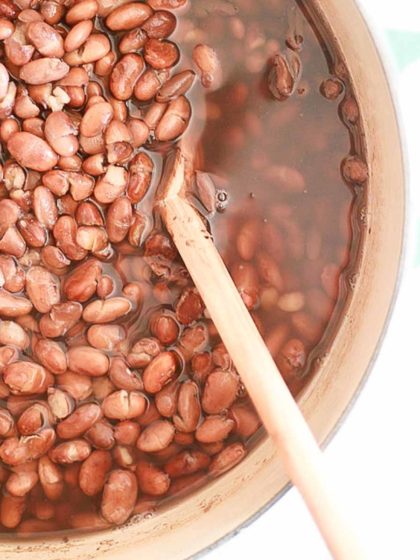
 I’m so glad you’re here! I’m a vegetarian home cook, certified plant-based pro, and mom. I’m married to an enthusiastic carnivore, and my mission is to achieve peace in the kitchen – one tasty recipe at a time. These days, with a name like mine, I also try not to ask to speak to the manager.
I’m so glad you’re here! I’m a vegetarian home cook, certified plant-based pro, and mom. I’m married to an enthusiastic carnivore, and my mission is to achieve peace in the kitchen – one tasty recipe at a time. These days, with a name like mine, I also try not to ask to speak to the manager.
I was thinking I could freeze beans and googled it! Thanks so much for your blog!. I’m doing this soon.
I cooked pot of pinto beans put pot in freezer to cool. Down and forgot them are they still good to eat
You can also cook them then freeze on a cookie sheet for about 2 hours then place them in whatever size zip-lock bag ( use gallon) you want. By pre-freezing they stay loose in the bag and you can then easily measure out what you want to use. You there by use less plastic bags. I suck the air out of the bag before completely sealing. I have a straw set aside for this purpose only. I don’t have ice build up in the bag.
I’ve been looking to prep more crock pot freezer meals and saw recipes that call for adding dried beans right in the bag with the other ingredients. You add a good amount of liquid (usually broth) to the Crock-Pot before cooking. But I’d like to cut down on the side effects of the beans. Can I use the quick soak method, then rinse, cool and not cook the beans prior to freezing them with the rest of the ingredients since they are going to be cooked in the crock pot anyways? And do I need to be concerned about the salt in the broth or recipe affecting the cooking of the beans in the Crock-Pot?
I know this is almost 3 years after the question was asked, but… I cook a lot of beans in the crock pot, and I cook freezer meals, but I’ve never added dried beans to a freezer recipe. My recipes tend to use canned beans, and I’m here because I would rather start cooking my own beans and keep them in the freezer. Because crock pots cook at relatively low temperatures, you risk undercooking the beans, even if you do 8+ hours on low. I use cooked beans in my freezer recipes that are later cooked in the crock pot, and the beans don’t disintegrate or turn to mush (probably because there’s little to no friction in a crock pot like you would get cooking something at a rapid boil). I would always recommend soaking beans prior to cooking them in the crock pot. If you’re adding all of the liquid to the container before putting it in the freezer, and you thaw your meals completely before cooking there may be enough time to effectively soak the beans as they thaw. I don’t think that method would be my preference, but it could work if there’s enough liquid. I cook beans in the crock pot in broth and it doesn’t seem to be an issue for me, but I tend to bump up cooking time to 9 or 10 hours if I start dinner early enough in the morning.
One note on crock pot cooking is that kidney beans really do need to be boiled (for the reasons the article mentions cooking them completely – I’ve always heard that they have to be boiled, and some people even recommend boiling, dumping that water, and then cooking in fresh water), so you can cook them in the crock pot only if you’ve boiled them for 15 minutes or more as part of a quick soak. I choose not to do kidney beans in the crock pot at all because of this – if I’m going to get the pot on the stove to quick soak, I might as well use that pot to cook the beans, too.
Don’t use canned beans the chemicals are terrible! If u were informed about simple things like poisons you should know! No canned goods! Education is key! I think that u need to read a cookbook or at least know what ur talking about!
I think YOU need to read the article. Sheesh.
Have always saved “bean juice” from cooking dried beans. Was running short on freezer space so I gently cooked down the leftover liquid and now make concentrated bean broth cubes by freezing in ice cube trays and dumping in a freezer bag. This is so handy when cooking; it also makes a wonderful cup of veg broth to sip on when you have reached your caffeine limit for the day.
The power of eating beans somehow gets underestimated, yet these small wonder foods have been proven to help serious illnesses like fighting cancer and heart diseases. This cooking and freezing the prepared homemade beans for later is a great idea than purchasing canned ones with already drained nutrients. Here’s a list of the healthiest beans that may also undergo the same step-by-step process of cooking and storing, without sacrificing the necessary nutrients down the drain.
Thank you for the advice. This worked great for black beans!
I usually cook my beans for when I’m going to cook with with later (chili, soup, baked beans) but how does it work for something like a bean salad? I worry that after freezing and thawing they’d be mushy. Have you tried this?
I’ve been cooking and freezing my beans for years and they’re fine to use in salads. 😋
I also just measure 3-4 cups to a qt ziplock bag and freezer that way (can wack against the counter to loosen to only remove half or whatever you need). Or toss bag in microwave for 30 sec works too.
Awesome. I love beans and always have been really good at making em. There’s just sooo many foods that change consistency after freezing. Love the link and thx for the insight. Keep it up. 💕☺️
Thanks so much, Sam!
Okay, I know you checked with the experts, so this is a dumb question, but I HAVE to ask: Storing them without liquid doesn’t make them freezer burn?
Also, do you happen to know if your same method above will work with jars instead of baggies? I don’t use plastic bags, but would LOVE to know that freezing drained beans is still safe and healthy!
(I don’t mind them being stuck together, as I freeze them in small portions, but I’d like to eliminate the thaw time of the water.) Thanks for this awesome, hope-inspiring post! Happy New Year!
Can I freeze cooked beans with the water I cooked them in?
Just make sure you get all the air out of the bag and you will have no problem.
Would like to freeze the beans with the cooking liquid … any issues? Thanks!
Does it hurt or Ruin dried pinto beans if they get frozen before cooking like a 50 pound bag being frozen in the garage are they still edible
cooked vs canned. be sure to factor in the cost of actually cooking them. still cheaper to use dry, but for truth sake, you cannot just compare the 2.
I flavor the liquid I use to cook the beans. If I drain them to freeze,won’t I loose all of the flavor?
can you freeze the chilli you put the beans in if they were frozen before
Thanks a lot – and thanks for fact-checking and the links. Cooking my beans to get them frozen right now – i add baking soda in the water where I let them sit, then again when I cook them – it’s supposed to make them more digest – well am addicted to baking soda, I use it for cooking and cleaning, beauty and health. And a lot of different vinegar mostly homemade.
Great article! I was wondering if I could steam hem, prior to freezing?
Thanks so much!
Thanks again for your expertise I have used this method time and again since I first discovered your site it’s foolproof and a delicious meal.
Thanks for your time,
Gary
This was great!!! The red beans took longer than the navy beans. On to doing the black beans and pinto beans. Thank you for a wonderful blog.
Thank you for the information on beans. I am new at this and I feel more confident now that I know what I am doing is the right thing. I am looking forward to buying fresh beans from now on.
Thank you so much for taking the time to write this article. I am currently cooking beans for the first time in my life from dried beans instead of canned. I realized that I made way too many beans and they only last in the refrigerator for a couple days. Thanks to your article I now know that I can put all my extra beans I am cooking in to the freezer instead of scrambling for ways to use them all within days. As a person learning the ways of prepping, thank you.
Thanks for this extremely helpful article. I have cooked beans before but not very successfully – I see now what I was doing wrong (not cooking for long enough and not draining them properly after cooking). I actually was looking to find if I could freeze cooked beans and you answered my question and much more! I have frozen a whole lot this evening in reusable plastic containers. I have also frozen the liquid the beans were in – it is a lovely rich, brown colour and I’ll use it for a soup base later.
Thanks again from Western Australia
Thank you for this post! I still haven’t caught on to cooking for two and always ends up with too much leftover. This worked so well on the Great Northern beans that I’m going to make pintos next week and freeze for a wonderful bean pot I make during the holidays. And now I have the other recipes on your site to go through!
Worked good
Thank you!
Thank you for making this so easy to understand, and do! I mad 2 pounds of navy beans! Now I can do this process with any beans my husband ( the bean eater in my home) desires:)
I was looking to see if I could freeze soaked beans. I came across this and was I happy. It is very simple. Simple can also have great outcomes. I also learned why you need to soak them first, you do not want the walking … sophomoric humor. 🤪 Five stars for sure, and I am very frugal with my stars. I just don’t hand 5 stars to everything I like. Remember, Beans beans are good for your heart, the more you…🤫🤪
Thanks for the great tips.